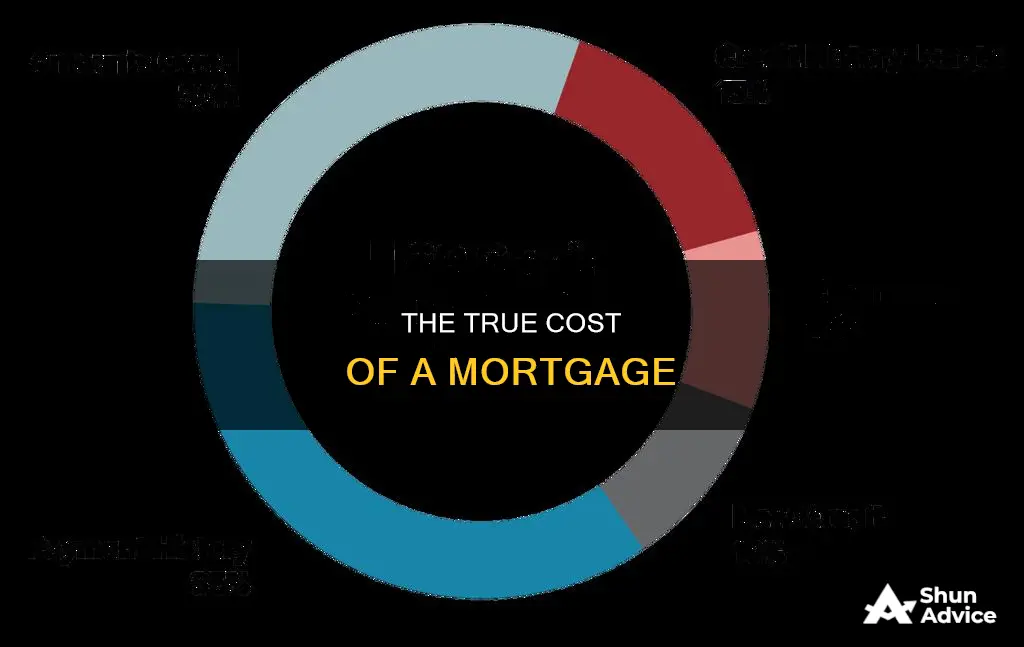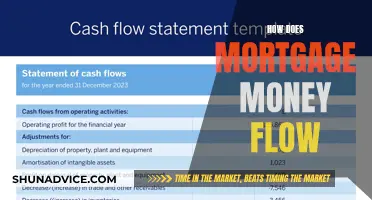
Taking out a mortgage is a huge financial commitment, and there are many factors to consider when determining how expensive it will be. The cost of a mortgage depends on the amount borrowed, the APR, and the repayment period. Typically, a larger down payment will reduce the amount of interest paid over time, and a shorter repayment period will reduce the overall interest paid, but will result in higher monthly payments. Other costs to consider include closing costs, property taxes, homeowners insurance, and mortgage insurance. Affordability calculators can help estimate how much house you can afford, but it's important to remember that a mortgage is a significant expense that should be carefully considered alongside other financial goals and expenses.
| Characteristics | Values |
|---|---|
| Down payment | Anywhere from 3% to 25% |
| Closing costs | One-time fees that typically run 2% to 5% of the mortgage |
| Property taxes | Tax on the home levied by the city or town, paid for as long as you own it |
| Homeowners insurance | Protects you financially from damage related to covered events |
| Mortgage insurance | Required if the down payment is less than 20% of the home's purchase price |
| Affordability | Monthly mortgage costs should be no more than 36% of gross monthly income |
| Loan term | 30-year fixed-rate mortgages are the most common, but 15-year mortgages are also an option |
| Interest rates | Volatile and subject to change over time; currently near a cyclical, long-term historical low |

Down payments
The cost of a mortgage depends on several factors, including the amount borrowed, the APR, and the repayment period. One of the most significant expenses is the down payment, which is the portion of the home's price that is not financed by a mortgage. While the required down payment can vary, it typically ranges from 3% to 25% of the total cost of the home.
The down payment is an essential factor in determining the overall cost of a mortgage. A larger down payment can result in significant savings over time. By paying a higher percentage upfront, borrowers reduce the principal amount owed, which in turn lowers the total interest paid over the life of the loan. For example, a 20% or larger down payment can help borrowers avoid the additional cost of private mortgage insurance (PMI), which is typically required if the down payment is less than 20%.
Additionally, the down payment can impact the monthly mortgage payments. A larger down payment reduces the principal amount, resulting in lower monthly payments. This can be especially beneficial for borrowers who may not have significant savings or upfront cash, as it makes homeownership more affordable and attainable. It is important to note that the down payment should not empty your savings account, and it is advisable to have some breathing room for other financial goals and unexpected expenses.
While a larger down payment offers financial benefits, it may not be feasible for everyone. Some loan programs, such as VA loans for veterans and active military personnel, offer flexible benefits and do not require a down payment. Additionally, there are low down payment loan options available, such as FHA loans, which allow for down payments as low as 3.5%. These options can make homeownership more accessible to those who may not have the financial means to make a substantial down payment.
In conclusion, the down payment is a critical aspect of the mortgage process, impacting both the overall cost and the monthly payments. While a larger down payment can result in significant savings, it is important to consider your financial situation and explore the various loan options available to find the best fit for your needs.
Lower Fees, Bigger Benefits: Refinancing Your Mortgage
You may want to see also

Monthly instalments
The cost of a mortgage depends on the amount borrowed, the Annual Percentage Rate (APR), and the repayment period. A mortgage is repaid in monthly instalments through a process called amortization. This process involves splitting the interest and principal into scheduled payments that remain the same. The principal is the amount borrowed, and the interest is what the lender charges to borrow this principal. Interest rates are expressed as an annual percentage and are determined by the current cost of borrowing in the economy and the borrower's creditworthiness.
The length of the repayment period will also impact the monthly instalments. A 30-year fixed-rate mortgage is the most common type of loan, offering lower monthly payments over a more extended period. This provides long-term stability and predictability, making it a popular choice for borrowers. However, it is important to note that with a 30-year mortgage, most of the initial payments go towards interest rather than paying down the principal amount, resulting in slower equity growth. On the other hand, a 15-year fixed-rate mortgage involves higher monthly payments but offers a lower interest rate and faster loan repayment.
Additionally, making a larger down payment can help reduce the overall cost of the mortgage and lower the monthly instalments. A down payment of 20% or more can help borrowers avoid the costs of private mortgage insurance (PMI), which increases monthly payments. Borrowers can also make extra payments to speed up the repayment process, reducing the overall loan term. However, it is important to be aware of any prepayment penalties that may be charged by lenders.
Exploring Mortgage Relief: Understanding 1031 Exchange Benefits
You may want to see also

Interest rates
The cost of a mortgage depends on the amount borrowed, the Annual Percentage Rate (APR), and the repayment period. The APR is influenced by the interest rate, which is determined by the current cost of borrowing in the economy and the borrower's creditworthiness.
Mortgage interest rates can be fixed or adjustable. A fixed-rate mortgage offers a set interest rate for the entire loan term, resulting in stable and predictable monthly payments. The 30-year fixed-rate mortgage is the most common type of loan in the United States, providing lower monthly payments over a longer period. However, it is important to note that in the early years of a 30-year loan, borrowers pay much more interest compared to a shorter-term loan. On the other hand, an adjustable-rate mortgage (ARM) can change over time, potentially increasing the interest rate and making the loan more expensive.
Money Flows: Understanding Mortgage Money Trails
You may want to see also

Closing costs
The specific closing costs you'll need to pay depend on the type of loan you borrow, where you live, and state requirements. For example, if you're buying a house in a flood zone, you'll need to pay $15-$25 for a flood certification. This money goes to the Federal Emergency Management Agency (FEMA), which uses the data to plan for emergencies and target high-risk zones.
Some costs are related to the property, while others are related to the mortgage lender's services and the paperwork involved in the transaction. Closing costs can include:
- Origination fees: the lender's processing fee, usually a percentage of the amount loaned (often 1%).
- Prepaid interest: funds for the initial payment of interest on your loan.
- Settlement and title fees: fees to officially transfer the property to the buyer and register the mortgage with the county records office.
- Property taxes: a fixed percentage based on the tax assessor's appraised value of your home that you pay to the county in which the home is located.
- Escrow account: an account that may be required to cover future payments for items like homeowner's insurance and property taxes.
Understanding TD Mortgage Escrow Changes and Notifications
You may want to see also

Property taxes
Whether or not property taxes are included in your mortgage payments depends on the terms of your mortgage contract. Your lender will usually explain this arrangement before you sign the loan, and it should be outlined in your loan documents. You may not have to include property tax payments in your mortgage payments if your lender doesn't require an escrow account or you request to waive this requirement. For instance, a lender may allow you to forgo an escrow account if you make a substantial down payment or have significant equity in the home.
It is important to factor in property taxes when calculating a potential mortgage payment. Property taxes can vary depending on where you live, with some locations being more expensive than others. A real estate professional who knows the local tax rates can be a valuable resource when navigating the house-buying process and ensuring that you stay within your budget.
Adding Someone to Your Mortgage: A Simple Process?
You may want to see also
Frequently asked questions
A mortgage is a loan to buy a home. After making a down payment, usually between 3% and 25%, a mortgage covers the remaining cost of purchasing a home.
The cost of a mortgage depends on the amount borrowed, the APR, and the repayment period. For example, a $415,000 loan at 7% repaid over 30 years will accrue $578,961 in interest, whereas the same loan repaid over 15 years will accrue $256,424 in interest.
The amount you can borrow for a mortgage depends on your financial situation. Lenders will assess your income, monthly debts, and credit score to determine how much you can afford to borrow.
You can use a mortgage calculator to estimate your monthly mortgage payments. These calculators take into account factors such as interest rates, loan term, and down payment to determine your monthly payments.
In addition to the interest on the loan, there are several other costs associated with a mortgage. These include closing costs, property taxes, homeowners insurance, and mortgage insurance if your down payment is less than 20%.







